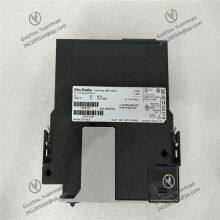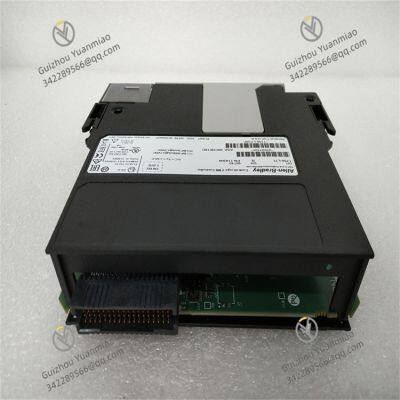I. Overview
1756-L71 is a high-end and high-performance processor module in Rockwell Automation's ControlLogix series, occupying a core position in industrial automation control systems. With top-tier computing power, strong processing performance, and rich functional expansion, it can easily handle high-difficulty control tasks in large-scale and complex industrial production processes. It can connect to a massive number of I/O modules to achieve precise control and data acquisition of large-scale equipment groups.
This module is widely used in large industrial scenarios with extremely high requirements for control accuracy, system stability, and data processing capabilities, such as large automobile manufacturing plants, large petrochemical complexes, and power system control centers. As a flagship component of the ControlLogix system, 1756-L71 works in collaboration with various input/output modules, communication modules, safety modules, etc. in the same series to build an ultra-efficient and highly reliable automation control system. It provides irreplaceable core support for the continuous and stable operation of large-scale production processes, the ultimate control of product quality, and the maximization of production efficiency.

II. Technical Parameters
Processor Performance: It adopts a top-level high-performance multi-core processor with an industry-leading main frequency (refer to the product manual for specific values). It has super-strong logical operation and parallel data processing capabilities, capable of handling dozens of complex control tasks and massive I/O data simultaneously, easily meeting the extreme requirements of large-scale control systems for real-time performance and response speed.
Memory Configuration: The capacity of program memory and data memory is extremely sufficient. For example, the program memory can reach 32MB, and the data memory can reach 16MB (the specific capacity is subject to the product data sheet). It can store ultra-complex control programs, huge process parameter libraries, and massive historical process data, supporting the development, operation, and expansion of ultra-large-scale control logic.
I/O Processing Capacity: It supports ultra-large-scale I/O point expansion. Through the ControlLogix rack and remote I/O network, it can connect hundreds or thousands of I/O modules, with the total number of I/O points reaching tens of thousands or even hundreds of thousands. It can meet the comprehensive collaborative control needs of multiple regions, multiple processes, and multiple devices in large industrial production lines.
Communication Interface: It integrates 2 or more Gigabit EtherNet/IP interfaces, supporting high-speed industrial Ethernet communication with a communication rate of up to 1Gbps. It can perform ultra-high-speed data exchange with HMI, SCADA systems, remote I/O stations, other high-end controllers, cloud platforms, etc., realizing global networked control and real-time monitoring of the system. At the same time, it supports multiple fieldbus communications such as ControlNet and DeviceNet (via expansion modules) and has Time-Sensitive Networking (TSN) support capability (for some models), greatly enhancing the system's communication flexibility, compatibility, and future expandability.
Power Requirements: It obtains power from the ControlLogix rack backplane, with a typical current consumption of about 2.2A at 5V DC (specific parameters are subject to the product data sheet). The power consumption matches the performance, with reasonable requirements on the system power load. It can work in collaboration with other high-power-consuming modules and needs to be used with a high-performance rack power supply.
Environmental Adaptability Range:
Operating Temperature: The normal operating temperature range is 0°C to 60°C, which can adapt to severe temperature fluctuations in industrial sites and maintain stable operation in different environments such as high-temperature smelting workshops, low-temperature storage areas, and normal-temperature central control rooms.
Relative Humidity: It can withstand 5% to 95% non-condensing relative humidity and maintain excellent performance stability in humid environments such as paper mills and coastal industrial areas.
Size Specification: It adopts the standard single-slot module size of the ControlLogix series, perfectly fitting the 1756 series rack. It is easy to install, saves rack space, and facilitates the integration and later maintenance of large-scale systems.
Certification Standards: It complies with multiple international authoritative industrial certification standards such as UL, CSA, CE, ATEX, and IECEx, ensuring safe and compliant use in various harsh industrial environments worldwide (including hazardous areas).

III. Functional Features
Ultra-Large-Scale Control Capability: Relying on the powerful performance of the multi-core processor and massive memory resources, 1756-L71 can be competent for the core control work of ultra-large-scale industrial control systems. It can run ultra-complex control programs including advanced algorithms (such as Model Predictive Control (MPC), adaptive control), complex logic control, multi-variable PID regulation, large-scale sequential control, etc., meeting the comprehensive control needs of complex production processes such as large-scale joint factories and cross-regional production lines.
Flexible I/O Expansion Architecture: It supports seamless connection with all types of I/O modules in the ControlLogix series and realizes distributed expansion through remote I/O networks (such as EtherNet/IP remote I/O). Users can flexibly configure the number and types of local and remote I/O points according to the production scale and layout, easily realizing flexible expansion and upgrading of the system to adapt to situations such as large-scale increase or decrease of equipment in the production line, major process changes, or plant expansion.
Intelligent High-Speed Communication: Through the integrated Gigabit EtherNet/IP interface and potential TSN support, it realizes the deep integration of control systems and information systems, supporting high-speed transmission and edge computing of a large amount of real-time data, facilitating intelligent monitoring, data analysis, and decision optimization of the production process. At the same time, the diversified communication methods enable it to easily access industrial Internet platforms, providing core support for enterprises' digital transformation.
Advanced Programming and Development Environment: It fully supports the advanced functions of Rockwell Automation's Studio 5000 programming software, including structured programming, object-oriented programming, library function reuse, etc., and provides multiple advanced programming languages such as ladder diagrams, function block diagrams, structured text, and sequential function charts. Engineers can use the software's simulation, debugging, version management, and other tools to efficiently complete the development, testing, and maintenance of ultra-complex control programs, significantly improving development efficiency and program quality.
Extreme Operational Reliability: It adopts military-grade high-quality components and a reinforced shell design, with excellent anti-vibration (complying with IEC 60068-2-6 standard) and anti-impact (complying with IEC 60068-2-27 standard) capabilities. It can withstand extreme mechanical stress and strong electromagnetic interference in industrial sites, ensuring long-term continuous and stable operation in harsh environments, and minimizing the risk of large-scale production interruptions caused by controller failures.
Comprehensive Diagnostics and Predictive Maintenance: It has powerful self-diagnosis, remote diagnosis, and fault early warning functions, which can real-time monitor the processor's operating status, memory usage, communication link quality, I/O module health status, power stability, etc. It analyzes equipment degradation trends through built-in algorithms and issues maintenance warnings in advance. Fault information can be pushed through indicator lights, communication interfaces, or cloud platforms, facilitating engineers to quickly locate and troubleshoot problems, realize predictive maintenance, and significantly reduce fault handling time and maintenance costs.
Massive Data Processing and Intelligent Analysis: It has strong data processing and storage capabilities, which can perform real-time analysis, compressed storage, and trend prediction on the collected massive real-time process data. It supports seamless integration with historians software to realize long-term data archiving and tracing. Through the built-in data analysis function, it can provide in-depth data support for production process quality optimization, energy consumption analysis, equipment performance evaluation, etc., helping enterprises achieve intelligent production management.
Safety and Compliance: It supports safety control functions (some models are GuardLogix versions), which can achieve SIL 3 safety level control, meeting the safety protection needs of industrial production for personnel, equipment, and the environment. At the same time, it has perfect access control, data encryption, and audit trail functions to ensure the security and operational compliance of the control system.

IV. Common Faults and Solutions
Startup Initialization Fault:
Phenomenon: The module fails to initialize after power-on, the power indicator is on but the running indicator is off or always on, there is no normal working response, and it cannot enter the running state.
Causes and Solutions:
Firmware Damage or Incompatible Version: Check the processor firmware version. If the firmware is damaged or incompatible with the system, reflash the matching latest firmware through Studio 5000 software; ensure stable power supply during the flashing process to avoid interruption.
Memory Fault: If the firmware is normal, it may be a memory hardware fault. Try to power off and restart the module. If it still cannot start, the module needs to be replaced.
Poor Contact with Rack Backplane: Check the connection between the module and the rack backplane, clean the contacts and re-plug the module to ensure tight contact; if the rack backplane slot is faulty, replace the rack or use a spare slot.
High-Speed Communication Interruption Fault:
Phenomenon: Communication with devices in the Gigabit EtherNet/IP network (such as HMI, remote I/O) is suddenly interrupted or data transmission is severely delayed, affecting system monitoring and control.
Causes and Solutions:
Network Link Problems: Check whether the Gigabit Ethernet cable is Cat 6 or above, and whether there is damage, excessive bending, or looseness; use a network tester to check the link quality and replace the faulty cable; check whether the network switch port supports Gigabit rate, restart the switch or replace the port.
Network Storm or Bandwidth Overload: Check network traffic through network monitoring tools. If there is a network storm or bandwidth overload, optimize network configuration, limit non-critical data transmission, increase network bandwidth, or adopt network segmentation.
Communication Interface Hardware Fault: If the network link and configuration are normal, the Gigabit EtherNet/IP interface of the processor may be damaged, and the module needs to be replaced or the interface repaired.
Program Running Crash Fault:
Phenomenon: The control program crashes suddenly during operation, the processor enters the fault mode, the output is held or forced to a safe state, resulting in production interruption.
Causes and Solutions:
Program Logic Errors or Memory Leaks: Analyze the program crash log in Studio 5000 software to find problems such as logical infinite loops, array out-of-bounds, memory leaks, etc., optimize the program code and re-download it; conduct segmented testing on complex programs to gradually locate error points.
Excessive Processor Load: Monitor the processor's CPU utilization. If it exceeds 80% for a long time, optimize the program structure, reduce unnecessary calculations and data processing, migrate some non-real-time tasks to edge computing devices; avoid a large amount of data processing or program downloading during peak hours.
Strong Electromagnetic Interference: Check whether the system grounding meets the specifications (single-point grounding, grounding resistance less than 4Ω), add special shielding layers and surge protectors to the processor and communication lines; keep away from strong interference sources such as high-power motors and frequency converters, or take isolation measures.
Distributed I/O Communication Fault:
Power Supply Abnormality Fault:














































